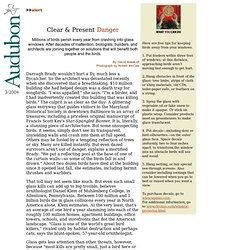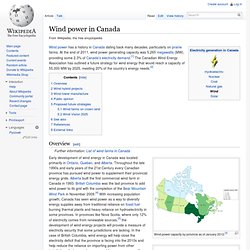

2012 Power of Wind Blog Contest » Friends of Wind. Friday, June 15th, 2012 To celebrate Global Wind Day and the growing contribution of wind energy in Canada, CanWEA has launched the Power of Wind Blog Contest.

Students entering post-secondary education are invited to submit a 300 word blog on the subject of wind energy. We want stories on what wind means to you and why you think it should be a part of our future energy mix. Use your imagination and be creative! Timing The contest will run from June 15th, 2012 (Global Wind Day) to September 15th, 2012. Prizes The winner of the Power of Wind Contest will win the following: 1st prize: $2,000 bursaryInvitation to deliver essay in person at CanWEA’s Annual Awards BanquetInvitation to climb the turbine at Exhibition Place 2nd prize: $500 bursary 3rd prize: $250 bursary Terms and Conditions The contest is open until September 15th, 2012.
Centre for Energy™ : Wind. As a member of Canada's Energy BOT Squad here's what you need to know.

Hey. I’m super renewable. I’m the third largest source of renewable electricity after hydro. And sure, I might not pack HydroBOT’s punch, but you only have to look at the Wolfe Island Wind Farm, the largest wind farm in Canada, to see that I’m starting to get powerful. Heating I may look like an overgrown fan that’s more likely to give you a cooling breeze, but an electric heater powered by wind will still keep you warm. Transportation. Centre for Energy™ : Electricity transmission in Canada. Previous | next Canada’s bulk transmission network consists of more than 160,000 kilometres of high voltage lines.

This is enough to cross the entire country roughly 27 times. These lines carry electricity at voltages above 50 kilovolts to move electricity in bulk over long distances. Transmission and Distribution in Canada. Like its neighbor to the south, Canada faces enormous costs to upgrade and expand its transmission and distribution system.

The desire to integrate more renewable power into the grid, build a smarter grid, and export more power are providing the rationale for action, but capital and political will lag behind. One of the great challenges facing any electrical system is the constant need for decisions regarding the transmission and distribution of power.
Canada’s high-voltage network consists of more than 160,000 kilometers of high-voltage lines. Beyond maintaining the aging facilities, operators are tasked with integrating more intermittent generation from renewable sources and incorporating smarter grid systems. Like generation decisions, decisions about transmission are mostly made at a provincial level. Canada has three power grids: the Western grid, the Eastern grid, and the Québec grid, which includes Atlantic Canada. Don’t count on constant electricity under renewable energy, says UK electricity CEO. Wind power will require lifestyle change Electricity consumers in the UK will need to get used to flicking the switch and finding the power unavailable, according to Steve Holliday, CEO of National Grid, the country’s grid operator.

Because of a six-fold increase in wind generation, which won’t be available when the wind doesn’t blow, “The grid is going to be a very different system in 2020, 2030,” he told BBC’s Radio 4. “We keep thinking that we want it to be there and provide power when we need it. It’s going to be much smarter than that. “We are going to change our own behaviour and consume it when it is available and available cheaply.”
Holliday has for several years been predicting that blackouts could become a feature of power systems that replace reliable coal plants with wind turbines in order to meet greenhouse gas targets. Smart grids are being developed by utilities worldwide to allow the government to control electricity use in the home, down to the individual appliance. Alert. >>alert Clear & Present Danger Millions of birds perish every year from crashing into glass windows.

After decades of inattention, biologists, builders, and architects are joining together on solutions that will benefit both people and the birds. By David Malakoff Photograph by Robert McCaw Darragh Brady wouldn't hurt a fly, much less a flycatcher. That toll may not seem like much. Glass gets less attention than other threats, however, because "most kills are pretty small, just a bird here or there," says Frank Gill, Audubon's director of science. That may be changing—in part owing to two decades of work by Klem, whom Gill calls "perhaps the only scientist to have gone at this problem systematically. " But efforts to reduce glass kills face formidable obstacles. Meanwhile, the hazard grows: Factories worldwide will churn out about 40 billion square feet of sheet glass this year, enough to cover the state of Rhode Island. That was only the beginning of the crystal era, however.
2012 Power of Wind Blog Contest » Friends of Wind. Canadian Wind Energy Atlas. Home - Canadian Wind Energy Industry. Wind power in Canada. Wind power has a history in Canada dating back many decades, particularly on prairie farms.

At the end of 2011, wind power generating capacity was 5,265 megawatts (MW), providing some 2.3% of Canada's electricity demand.[1] The Canadian Wind Energy Association has outlined a future strategy for wind energy that would reach a capacity of 55,000 MW by 2025, meeting 20% of the country’s energy needs.[2] Overview[edit] Wind power capacity by province as of January 2012.[3] Wind power capacity in Ontario by county as of January 2012. Note the concentration along shorelines. L’Association canadienne de l’énergie éolienne (CanWEA)